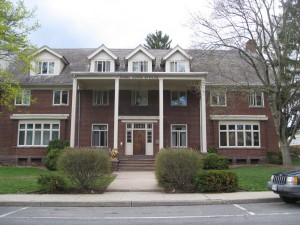By Meghan Finlayson
Writer
The first annual Day of Service for first-year students was held last Saturday, August 27. Students were invited to different sites around Lewisburg to learn about the community service opportunities in the area.
The Dreamcatcher Farm, Sunbury YMCA, Milton YMCA, Essex Place, Meadowview, Donald Heiter Community Center and Elijah’s Bowl all hosted students.
Jenna Weaver ’15 said, “It’s really neat to see all the different ways you can get involved in this Lewisburg community. There are so many people that want to reach out to those in need and it was really apparent that Bucknell students can help make a big difference.”
About 40 faculty and staff members volunteered.
“We thought this would help newcomers … see some of the opportunities to be involved in non-profit areas and local enterprises, and recognize the value of civic engagement while working with a group of peers to make a difference,” said Lynn Pierson, assistant director for community service.
Many first years agreed. “Participating in the first year day of service was a great way to meet members of my class and do some good for the local community around Lewisburg. I would definitely recommend it to incoming freshmen for next year,” said Daniel Ambrose ’15.
The idea for the Day of Service came from recommendations from the Faculty Advisory Committee on Teaching (FACT), which hopes to inspire first-years to be more active in the Lewisburg community.
“We want to emphasize opportunities to be engaged in meaningful activities throughout their educational experience in and out of the Bucknell classrooms,” Pierson said.
Jeffery Campbell, event technology specialist, was assigned to go to the Sunbury YMCA with a group of students to paint a day care room.
“Not only is the Day of Service good for town relations, it exposes the students to situations and environments that they may not have ever been exposed to. In that sense, I think it provides a valuable learning experience and maybe will show the value of community service,” Campbell said.
Lynn Breyfogle, associate professor of mathematics worked with students to clean, decorate and prepare the Donald Heiter Community Center for after-school care.
Susquehanna University students also attended the event. “With all the students there, there was a festive and wonderful feeling of everybody volunteering and helping out the center,” Breyfogle said.
The day also gave faculty and students a chance to meet and connect. “It was nice as a faculty member to meet students I might not have otherwise met,” Breyfogle said. “The students worked very hard, and they were interested and engaged in what they were doing.”
“In all, I think [the students] enjoyed their day and thought that the Day of Service was a valuable and important asset to the community,” Campbell said.
The Office of Civic Engagement hopes this will be a tradition that continues in the future.

